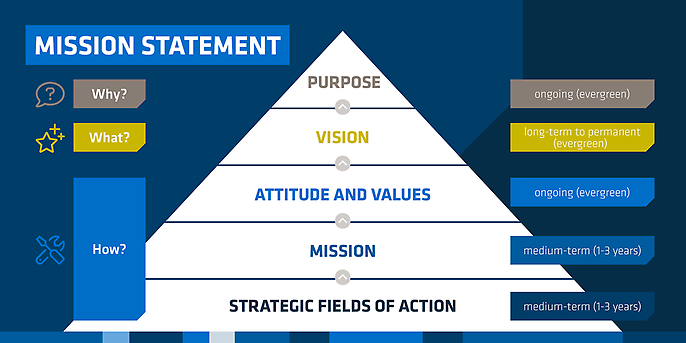19. August 2022 By Joachim Flierdl
Why companies should have a mission statement and how to develop a good mission statement
‘If you have visions, go see a doctor!’ Former German Chancellor Helmut Schmidt once famously said these words. However, only few people know how to put them in the right context. Helmut Schmidt did so himself many years later in his unique, succinct style when he was asked about that quote in an interview: ‘It was a snotty answer to a silly question.’
Helmut Schmidt no doubt was a pragmatist. Nevertheless, he also had very clear and ambitious goals, and that is what this article is about. Why should companies set themselves goals and how do you formulate them in an understandable and comprehensible way so that everyone in the company can rally behind them?
For, as poet Christian Morgenstern once said: ‘If you are not aware of the destination, how could you possibly know the way?...’.
So the most obvious answer to the ‘why?’ is ‘orientation’!
Knowing your bearings at any time and in any phase of a company’s development. Therefore, beyond the short-term horizon of day-to-day operations, companies should also pursue medium- and long-term goals. And along with it an ‘evergreen’ vision that remains valid forever.
Neither arrogance nor fantasies of omnipotence fuel the pursuit of a vision. All we need it to do is provide a permanent beacon of orientation, even if we have already successfully completed a major mission.
Some companies also try to gain orientation through the definition of corporate purposes, attitudes and values that set guidelines for our daily work. I will summarise all of these points under the term ‘mission statement’, which I would like to explain to you in more detail below.
Definition of terms
One thing in advance: while a lot of excellent material on this topic is out there on the web, there is no uniform definition for a corporate mission statement. In order to avoid becoming bogged down in discussions revolving around terminology when drafting the mission statement, it is advisable to set out clear and comprehensible methodological guidelines.
A mission statement should have an impact at all corporate levels. On the one hand, it should be specific enough so your company can derive guidance for making the right decision, for example in moments of crisis. On the other hand, it should not be too concrete, for this would make it sound like a codified dictate from above. The differentiation and specification should therefore be left to the individual departments.
Furthermore, the mission statement should not be developed by management in a sealed off conference room, but rather in concerted workshops, whose participants provide a representative cross-section of the people who work at the company. You can start off by collecting input and opinions of the participants through guiding questions and then put these to the vote to determine their relative importance. If you follow this advice, the final step of formulating clear and concise sentences will not be difficult, and the staff will be much more inclined to approve.
In the following, I will describe some definitions and guiding questions that have worked well for me in this context. However, they are not necessarily universally applicable. The following graphic provides an initial overview of the terms and their interrelationships. Below, I will describe the individual elements in detail:

Purpose
The purpose of a company is its higher meaning, the goal and benefit of the company that goes beyond making profit.
Admittedly, there is a difference of opinion when it comes to purpose. Some consider it to be trendy frippery or mere marketing claptrap. Others, especially many young people, take the same view as Simon Sinek: ‘Always start with why.’
If the purpose is worded like a hollow claim that even the company’s own employees do not find credible, then it is certainly more harmful to the corporate image than useful. Personally, I agree with Peter F. Drucker, the pioneer of management theory: ‘The purpose of a business is to attract and serve customers.’
So to me, if the purpose manages to establish a clear and credible connection to the customer, it’s a sound one. The important thing is that the purpose of a company does not equate with maximising profits, despite what many business economists are still preaching today. I’d just like to make it clear at this point that I do not buy into exaggerated expectations of corporate social responsibility, especially when they border on altruism. I also have nothing against corporate profits.
However, balance sheets and company profits do not provide any orientation as to how a company should adapt in disruptive times in order to remain competitive. Profit is therefore neither the purpose nor the goal of a company, but merely a necessity.
To develop a purpose in a large group, it is useful to gather information and opinions by means of guiding questions. For me, the following guiding questions have always worked well:
- What makes us proud when we talk about what we do for our customers?
- What do we really enjoy about our work?
Vision
The vision is the distant, highly ambitious and inspiring ideal. It is about the long haul, ideally an ‘evergreen’ notion that does not change – not even if a company has already achieved major milestones or successfully completed a mission.
A good vision focuses first and foremost on the benefits that a company creates for its customers. It should be short and crisp so that everyone in the company can recite it by heart at any time. Since both the purpose and the vision should provide long-term orientation, they can also be combined with each other.
My favourite example here is amazon’s first vision, which can be understood as both a purpose and vision: ‘It’s our vision to be Earth’s most customer-centric company, where customers can find and discover anything they might want to buy online.’
When developing your own vision, it is particularly important to steer the opinion-forming process within the company and its individual departments by means of guiding questions. Under no circumstances should you get caught up in product visions. This rarely works, because the collected ideas of potential future products are usually nothing more than a bunch of solution hypotheses that no one can really foresee in advance.
At worst, such product visions run counter to an iterative and incremental approach and delay early market entry. Feel free to also read my blog post on the Lean start-up principle (build-measure-learn – maximise customer value and avoid waste) if you are interested in getting more details.
The guiding questions should therefore focus on the ‘what?’ while avoiding a precise ‘how?’:
- What is the greatest benefit that our products deliver to our customers?
- What is it that would inspire me as a customer about our products?
- What is the possible extent of our growth, and what is the greatest possible ambition?
Attitude and values (mindset)
While vision is a highly ambitious goal, attitude and values deal with the important overarching ethical beliefs that should guide our decisions and actions. This is often referred to as mindset, which is of great importance especially in the context of agile transformation.
Values such as commitment, cooperation, effectiveness, courage, focus, trust, willingness to learn, openness and transparency provide orientation for our daily interactions.
Here, too, guiding questions can help us to gauge an opinion within the company, but also to shape it:
- What view of humanity should define our corporate culture?
This question that aims at whether we rather believe in a humanity that learns and grows with their tasks, which is intrinsically motivated and works best when working in a self-organised and self-reliant way? Or do we rather believe in supposedly ‘innate’ talents and hope that extrinsic incentive systems and tightly managed work will make the people in our company perform at their best? - What values do we stand for?
Mission
While all the terms mentioned so far are long-term or ‘evergreen’ in nature, the mission focuses on a medium-term period of one to three years. It is intended to outline our next big task, which we will undertake specifically in order to bring our vision closer to reality and to live up to our purpose.
A good mission is short and crisp so that everyone in the company can recite it by heart at any time.
Guiding questions:
- Where do we want to be three years from now?
- What benefits does this create for our customers?
- Are we confident that the mission brings us closer to our vision?
Strategic fields of action
Operationalising the next mission requires strategic action. To this end, you should ask yourself the following guiding question in particular: who or what do we need to make the next mission succeed?
Possible dimensions could be, for example, customer centricity, benefit maximisation, process effectiveness and the like.
But you should never forget about healthy and committed employees because you can’t succeed without them. This is probably one of the reasons why amazon has since revised its vision and now also speaks of being ‘...Earth’s best employer, and Earth’s safest place to work...’.
The strategic fields of action, often also called strategic pillars or levers, can then be derived from the dimensions, which give us structure over the medium term. However, the strategic fields of action are not concrete goals. They rather define the playing field on which we are allowed to grow.
Conclusion
In order to create a good mission statement for your company, you do not always need all the elements mentioned in this post, and certainly not all at once. However, it is important to set forth clear methodological and conceptual guidelines right at the beginning and to collect the opinions of a broad and diverse group of people in the company by means of guiding questions. This will make the result more comprehensible and binding.
Nevertheless, this is only the first step. The second step is about bringing the developed mission statement to life in daily work, in other words, to operationalise it. Read more about this in a separate blog post.
Would you like to learn more about exciting topics from the world of adesso? Then check out our latest blog posts.

